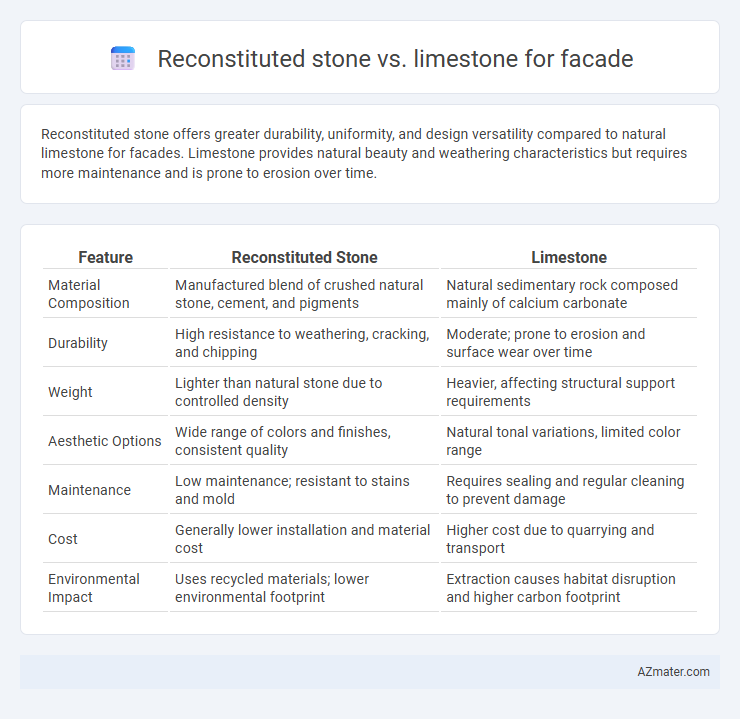Reconstituted stone offers greater durability, uniformity, and design versatility compared to natural limestone for facades. Limestone provides natural beauty and weathering characteristics but requires more maintenance and is prone to erosion over time.
Table of Comparison
| Feature | Reconstituted Stone | Limestone |
|---|---|---|
| Material Composition | Manufactured blend of crushed natural stone, cement, and pigments | Natural sedimentary rock composed mainly of calcium carbonate |
| Durability | High resistance to weathering, cracking, and chipping | Moderate; prone to erosion and surface wear over time |
| Weight | Lighter than natural stone due to controlled density | Heavier, affecting structural support requirements |
| Aesthetic Options | Wide range of colors and finishes, consistent quality | Natural tonal variations, limited color range |
| Maintenance | Low maintenance; resistant to stains and mold | Requires sealing and regular cleaning to prevent damage |
| Cost | Generally lower installation and material cost | Higher cost due to quarrying and transport |
| Environmental Impact | Uses recycled materials; lower environmental footprint | Extraction causes habitat disruption and higher carbon footprint |
Introduction to Facade Material Choices
Reconstituted stone offers a versatile and cost-effective alternative to natural limestone for facade applications, providing similar aesthetic appeal with enhanced durability and lower maintenance. Limestone, a traditional facade material, is valued for its natural texture and timeless elegance but requires careful sealing and upkeep to prevent weathering and discoloration. Choosing between reconstituted stone and limestone depends on factors such as budget, design flexibility, environmental conditions, and long-term maintenance requirements.
What is Reconstituted Stone?
Reconstituted stone is an engineered material made from crushed natural stone, binders, and pigments, designed to replicate the appearance and texture of natural stone such as limestone. It offers increased uniformity, enhanced durability, and greater design flexibility compared to traditional limestone, making it ideal for facade applications that demand consistent aesthetics and weather resistance. The manufacturing process allows customization in color, shape, and size, providing architects with diverse options while often reducing costs and environmental impact relative to quarrying natural limestone.
Understanding Natural Limestone
Natural limestone offers unique textural depth and weathering patterns that enhance facade aesthetics, distinguishing it from reconstituted stone's manufactured consistency. Composed primarily of calcite, natural limestone forms over millions of years through sedimentation, providing inherent variations in color and grain that cannot be perfectly replicated. Its porosity and durability also influence maintenance and longevity, making it a preferred choice for authentic architectural applications.
Aesthetic Differences: Reconstituted Stone vs Limestone
Reconstituted stone offers a uniform texture and consistent color palette, allowing for precise design control on facades, while limestone displays natural variations and unique veining that enhance its organic aesthetic appeal. The smooth, manufactured finish of reconstituted stone provides a modern, polished look, in contrast to the warm, timeless character imparted by the weathering patterns and granular surface of natural limestone. Selecting between these materials depends on whether a facade seeks the predictability of engineered stone or the authentic, varied beauty of natural limestone.
Durability and Weather Resistance
Reconstituted stone offers superior durability compared to natural limestone due to its engineered composition, which enhances resistance to cracking, chipping, and erosion. Limestone, while aesthetically appealing, is more porous and susceptible to weathering effects such as acid rain and freeze-thaw cycles, leading to surface degradation over time. For facade applications requiring long-term structural integrity and minimal maintenance, reconstituted stone provides enhanced weather resistance and longevity.
Sustainability and Environmental Impact
Reconstituted stone offers enhanced sustainability compared to traditional limestone due to its use of recycled aggregates and lower quarrying impact, reducing natural resource depletion. Limestone extraction involves extensive mining, leading to habitat disruption and significant carbon emissions, whereas reconstituted stone production typically results in a smaller carbon footprint. Choosing reconstituted stone for facades supports eco-friendly construction by minimizing waste and promoting resource efficiency while maintaining aesthetic similarities to natural limestone.
Cost Comparison and Budget Considerations
Reconstituted stone generally offers a more cost-effective solution for facades compared to natural limestone, with prices typically 20-40% lower due to reduced quarrying and transportation expenses. Budget considerations include installation labor costs, where reconstituted stone often allows faster application and lower skilled labor requirements, further decreasing overall expenditures. Long-term maintenance costs are comparatively similar, but the initial investment makes reconstituted stone a more budget-friendly option for projects aiming to balance aesthetics and affordability.
Installation Process and Maintenance Requirements
Reconstituted stone offers a more consistent size and weight, simplifying the installation process with quicker setting times and easier handling compared to natural limestone, which can be heavier and more irregular in shape, requiring skilled labor to fit properly. Maintenance for reconstituted stone typically involves less frequent sealing and is more resistant to staining due to its engineered composition, whereas limestone, being a porous natural material, demands regular sealing and careful cleaning to prevent weathering and discoloration. Both materials require routine inspection, but limestone may incur higher long-term maintenance costs due to its susceptibility to erosion and acid rain damage.
Popular Applications in Facade Design
Reconstituted stone offers enhanced durability and uniformity, making it popular for modern facade designs in commercial buildings and urban residential projects where precision and consistency are crucial. Limestone remains a favored choice for historic restorations and luxury facades due to its natural texture and timeless aesthetic. Both materials serve key roles in facade architecture, with reconstituted stone excelling in customizable applications and limestone prized for its classic appeal.
Making the Right Choice for Your Project
Reconstituted stone offers enhanced durability, uniform appearance, and greater design flexibility compared to natural limestone, making it ideal for contemporary facade projects requiring consistency and strength. Limestone, valued for its authentic texture and natural aging process, suits historical restorations and traditional architecture where authenticity is paramount. Choosing between reconstituted stone and limestone depends on project requirements such as budget, aesthetic goals, climate resistance, and maintenance needs.

Infographic: Reconstituted stone vs Limestone for Facade
 azmater.com
azmater.com